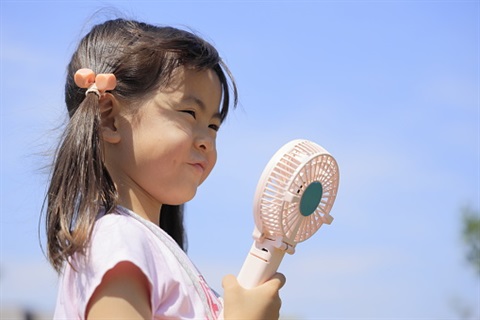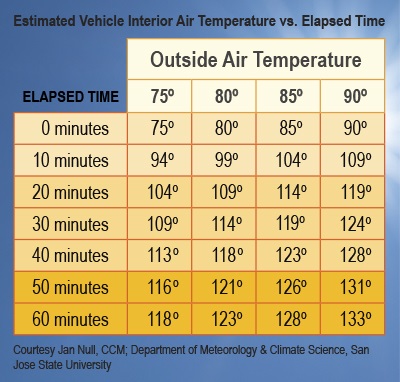HEATSTROKE

Heatstroke is the leading cause of non-crash, vehicle-related deaths for children.
Sometimes babies sleep so peacefully that busy parents can forget they are even there. Other times, we might be tempted to leave kids in the car while we run into the store or dash off to do an errand. Children can also end up alone in cars if the doors or trunk are left unlocked. However it happens, an average of 38 kids die each year from being left unattended in a vehicle – that's one child every 10 days! That's why children should never be left alone in a car, not even for a minute. It can lead to heatstroke, which causes serious injury or even death.
Heatstroke, also known as hyperthermia, occurs when the body can't cool itself quickly enough and the body temperature rises to dangerous levels. Young children are particularly at risk, as their bodies heat up three to five times faster than an adult's.
 But heatstroke doesn't only happen on hot days. Children are still at risk even in cooler temperatures because of how quickly a car can heat up. On average, the temperature inside a vehicle will rise 19 degrees in just 10 minutes. For children, this increase is enough to result in death.
But heatstroke doesn't only happen on hot days. Children are still at risk even in cooler temperatures because of how quickly a car can heat up. On average, the temperature inside a vehicle will rise 19 degrees in just 10 minutes. For children, this increase is enough to result in death.
This tragedy is 100% preventable. Here's how we can work together to help keep heatstroke from happening.
Look before you lock and ACT
- A: Avoid heatstroke-related injury and death by never leaving a child alone in a car, not even for a minute. And make sure to keep your car locked when you're not inside so kids don't get in on their own.
- C: Create reminders. Keep a stuffed animal or other memento in your child's car seat when it's empty and move it to the front seat as a visual reminder when your child is in the back seat. Or place something in the back seat of your car next to your child such as a briefcase, purse or cellphone that is needed at your final destination.
- T: Take action. If you see a child alone in a car, call 911. You don't know how long they've been there, so don't waste any time. Emergency personnel want you to call. They are trained to respond to these situations. One call could save a life.
Teach kids not to play in cars
- Make sure to lock your vehicle when you're away from it, especially in the garage or driveway, and remind your neighbors to do the same.
- Keep keys and remote entry fobs out of children's sight and reach. Nearly three in 10 heatstroke deaths happen when an unattended child gains access to a vehicle; once inside, they are quickly affected by the heat, becoming disoriented and unable to escape.
- Teach children that trunks are for transporting cargo and are not safe places to play.
- Teach children to honk the horn if they become stuck inside a vehicle.
- If a child is missing, immediately check the inside, floorboards and trunk of all vehicles in the area. Get kids who are locked in cars out as soon as possible. If you can't do so quickly, dial 911 right away. Emergency personnel are trained to evaluate and check for signs of heatstroke.
Create extra reminders
- If you regularly drop your child off at child care, create a calendar reminder on your phone or computer to make sure you've done so. Or, set the alarm on your cell phone as a reminder to drop your child off at child care. Remember to make the alarm song/sound different from all other alert sounds on your device.
Communicate with your child care provider
- Make arrangements for your child care provider to call you right away if your child doesn't show up at the expected time. Be especially careful during busy times, holidays, schedule changes and periods of crisis, as heatstroke incidents often occur when people's routine is disrupted. If you have a change in routine, such as your spouse or parent dropping your child off at child care instead of you, make sure you and the other person communicate to confirm the drop-off was made.
LEARN MORE
www.noheatstroke.org - Study of trends and patterns in U.S. child vehicular heatstroke deaths, including statistics, safety recommendations and vehicle heating information.
www.kidsandcars.org - Heatstroke stories, fact sheets, safety tips, charts, graphics, PSAs, studies and more.
www.nsc.org - Hot car resources and a free online course from the National Safety Council.
www.nhtsa.gov - Tips from the National Highway Traffic Safety Administration to avoid child heatstroke.
www.healthychildren.org - Facts from the American Academy of Pediatrics about hots cars and keeping kids safe.
www.safekids.org - Take action to prevent heatstroke with free downloadable toolkits for child care providers, first responders and the community.
www.preventheatstroke.org - Adopt a free CB (Check Backseat) as a handy memory aid to always look before you lock.